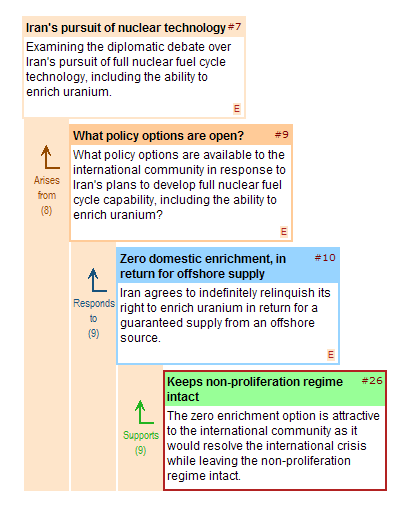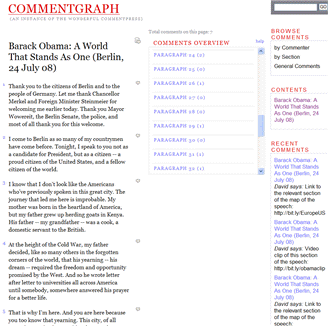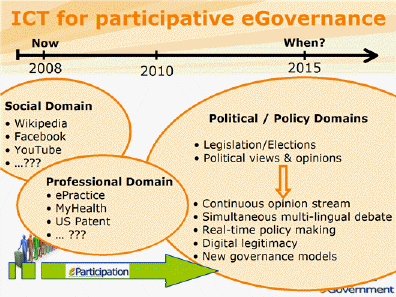Question: What do you get if you cross a wiki, a forum, a blog, instant messaging, and social bookmarking with an argument map?
Answer: Debategraph.org
I started to collaborate on Debategraph with, my co-founder, Peter Baldwin in 2005. It’s one of those delightfully unlikely collaborations that the Internet makes possible: I’m based in Somerset in the UK and Peter is based in the Blue Mountains in Australia. We discovered each other, across the net, because we had two things in common: a shared perception of a problem and a shared idea for a solution.
The perceived problem is that the way that we address and resolve complex and contentious issues in public life is broken—and it is broken at a time when it has never been more important for those systems to function effectively. This is not an original conclusion, and it’s one that others have discussed elsewhere at length, but it was a conclusion that flowed directly from our personal experience: in Peter’s case as a former minister of higher education and cabinet minister for social security in the Keating administration in Australia, and in my case as a former advisor to, amongst others, H.M. Treasury, DCMS, DTI, and Ofcom.
What really brought us together though was not the diagnosis but the perception of a potential solution. This perception was threefold, that:
- contentious and complex debates can be mapped comprehensively so that all pertinent issues, positions, arguments, evidence, and scenarios are represented in a transparent and coherent visual structure;
- the web can be used to externalise and open up this process to anyone interested in contributing to, rating, or simply exploring the map; and
- mapping debates in this way would benefit individuals and society.
In essence, debate mapping involves three steps:
- breaking down the subject debated into meaningful parts;
- identifying the relationships between those parts; and,
- presenting the parts and their relationships visually.
To illustrate this:

The image above shows a small strand of a map beginning to explore the options open to the international community in response to Iran’s pursuit of nuclear technology. A policy option—zero domestic enrichment in return for offshore supply—is identified and an argument in support of this position suggested—that the option would defuse the international crisis without disrupting the existing nuclear non-proliferation treaty.
A large map is simply made up of many of these kinds of small combinations of thought boxes.
The contents of each box can be edited and rated over the web, and anyone can add new boxes (issues, arguments, and positions etc) to the map. Each box also has an underlying detailed display to which images, charts, tables, full-length essays, free form comments and links to external documents can be added. As well as forming part of the vertical tree structure, the boxes can be semantically linked to any other box in the same map or different map(s).
Collaborative editing of the maps across the web makes it possible for the collective knowledge and insights distributed across the entire community of interested participants to accumulate in the map. Anyone who spots a gap or a loose end in the map or who identifies a new option can add this to the map immediately for all to see. In this way, initial seed maps can evolve towards mature and comprehensive views of debates to which, at least temporally, no one has anything else to add.
So what are the benefits? To begin with, the maps augment our individual and collective ability to think through complex challenges, by helping us to overcome the cognitive constraints of short-term memory and group processes such as homophily. They allow us to apply our minds to the full set the arguments rather than a partial subset, and, by reasoning openly, help us to reason more rigorously. Early quantitative evidence of the benefits of argument mapping is beginning to be gathered in an educational context.
Second, the maps provide a way to systematise the dialogue and deliberation processes used in, for example, the Harvard Negotiation Project and citizen juries across society. Just as mediation creates a physical space in which a conflict can be explored and resolved, the debate maps provide an online context in which conflicting values and interests distributed across multiple stakeholders can be surfaced and addressed openly and in an explicitly reasoned way. There’s no presumption of underlying consensus, but methods of this kind can facilitate the discovery of unforeseen creative solutions if they are there to be found.
Third, the transparency and openness of the maps help to engender trust in the policy making process on the part not just of the participants but also the observing majority. The transparency also makes it harder for the debate to be spun for political, commercial or media effect—and, by making the reasoning behind decisions explicit, the maps also bring a degree of retrospective accountability and learning to the decision making process.
Fourth, as each idea, position, and argument only has to be stated once on the map, the process is highly time efficient in comparison to traditional consultation methods in which multiple documents from different sources end up rehashing many of the same arguments (all of which have to be written and read each time). Freeing people from writing and reading redundant material creates a cognitive surplus that can be focused on the substance of the debate.
So that’s the theory, where are we in practice?
Well, we are a long way down a long road. We piloted the software with the Prime Minister’s Office and the Royal Society of Arts last summer, and have also begun to apply the mapping approach to other domains—for example, exploring 50 years of academic debate on the prospects for artificial intelligence.
We launched Debategraph.org in the spring this year as a free, creative commons, social venture and are proud signatories to the Cape Town Open Education Declaration and enthusiastic participants in the Open Knowledge movement. The content on the site is growing steadily, and as more people become familiar with the mapping approach, our goal is for Debategraph to mature into a significant public resource: a global map of interrelated debates in which the best arguments on all sides of any contentious public issue are continuously available for all to see and for all to improve.
In the short term, we are embarking on an international project on climate change with various public and private sector partners, including the MIT and the Open University. And, in preparation for this, we have just released a new feature that lets you embed automatically updating snapshots of debates on blogs and websites (see the Iran map example below).
There’s much still to be done though: we’re in an early phase of our long-term development, with plenty of scope for refining and simplifying the user interface and for introducing different map visualisations, and there are significant social and cultural challenges ahead too. So if you are a natural pioneer, interested in experimenting with Debategraph in a field that matters to you and in helping to fulfill the nascent potential of this new category of tool, we would love to hear from you.





